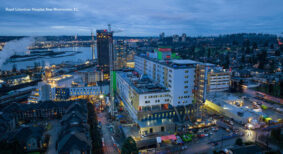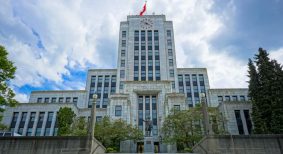As communities across Canada grapple with population growth and changing demographics, the pressure to create more housing has never been greater. The need for housing has reached critical levels as demand continues to outpace construction. Market pressures such as increasing material costs, regulatory complexities, and skilled worker shortages in jurisdictions across Canada have created significant barriers to the rapid development of much-needed housing.
In this challenging landscape, innovative construction solutions are more crucial than ever. One way to address these challenges, according to Rory Koska, executive director of WoodWorks Alberta, is to bring more of the construction process from the construction site to a manufacturing facility.
“Wood-based systems are inherently well-suited to prefabrication and the growth of offsite manufacturing presents a compelling path forward. Factory-built solutions optimize use of both materials and labour, helping to reduce waste, improve efficiency and productivity, and shorten time on site,” says Koska.
Prefabricated wood solutions, in all their various forms, not only offer a lower carbon approach to construction but are also uniquely positioned to accelerate the delivery of housing and other critical infrastructure. Increased adoption of mass timber and other engineered wood products in construction can help bridge the gap between housing demand and supply with sustainable, manufactured solutions.
The modern suite of mass timber products—such as cross-laminated timber (CLT), glue-laminated timber (GLT), nail-laminated timber (NLT), dowel-laminated timber (DLT) and others—is revolutionizing the way designers and developers approach construction. These advanced panel products enable a wide range of structural solutions that can be tailored to the unique needs of each project, supporting flexibility and driving innovation.
Increasingly, projects are pursuing mixed material solutions that optimize the structural, aesthetic, and performance characteristics of each component. While many hybrid solutions involve a mix of steel and wood, concrete and wood, or even all three major materials together, there’s an interesting ‘all wood’ or ‘mostly wood’ subset of hybrid construction that has found strategic efficiencies by mixing light wood frame solutions with mass timber.
An all-wood approach to hybrid construction delivers many of the same benefits as other hybrid solutions, but without some of the scheduling and integration complexities that can come from mixing disparate materials. By leveraging hybrid systems that combine light wood frame construction, often in panelized forms, with various types of mass timber components, project owners are successfully delivering high-performance buildings in shorter timelines.
Realistically, there’s no universal solution, but the versatility offered by combining light wood frame with mass timber is an effective strategy for developers seeking efficient solutions. This approach enhances a given project’s adaptability to local and regional supply chains, ensuring that environmental and economic efficiency by selecting the product mix most readily available in each community.
A notable residential project in Red Deer is the Red Deer Polytechnic Student Residence. For this integrated project delivery (IPD) project, the composition of the superstructure was decided through a collaborative team exercise called ‘Choosing by Advantages’ (CBA) where concrete, steel, wood, and a composite system were compared to determine the best structural approach. The resulting five-storey midrise building is a hybrid structure with glue-laminated timber (GLT) posts and beams for the structural frame, GLT panels for the floor and roof systems, and dimensional lumber for the load-bearing walls, shearwalls, and interior partitions. This approach was determined to provide the most advantages for the project at the least cost. The only significant non-wood element is a steel skeleton on the first storey which supports a glulam transfer slab. The podium was assessed in a separate CBA exercise where steel was chosen for the first-floor columns and beams.
According to Vedran Škopac, principal at Reimagine Architects, the wood hybrid structural approach had several advantages. “The design minimized beam depth in the ceiling and optimized costs. It also positively impacted the speed of construction for both the structure and plumbing services.” The project had many other notable achievements in terms of sustainable design, energy performance and occupant experience.
A similarly successful hybrid project currently under construction in Vancouver takes a slightly different approach, using Cross-Laminated Timber (CLT) over panelized light frame construction instead of GLT. Vienna House is a near zero-emissions rental apartment community that incorporates CLT floor and ceiling panels over prefabricated light frame wall construction. The CLT provides diaphragm/shear stability and transfers the load bearing light frame construction. The system also incorporates seismic reinforcing tension rods in the shearwall system due to the project’s location in a higher seismic zone. Once complete, the community will consist of 123 units, including 56 family units, all mixed between shelter, low-income, and average market rental units.
The highly prefabricated hybrid design, utilizing light wood frame and CLT panels, was selected, in large part, for its environmental performance and its ability to expedite construction. The prefabricated components brought value to the project because they facilitated the advanced planning and digitization of the project, and the manufacturing efficiencies support on-site activities and improve the precision of construction. Other benefits include a safer job site, reduced labour requirements on site, and a reduction of construction noise and other impacts on the surrounding community.
Devin Harding from Kalesnikoff, cited the reduced construction schedule as a key advantage of the project, but also praised the beautiful aesthetic that results from exposing the mass timber. “From a quality perspective, using a manufactured product like CLT for the floor system improves stability and the squareness of the walls, which benefits layout for MEP rough in and finishing trades material usage.”
Both buildings stand out for their innovative, hybrid design solutions and offer desirable solutions that can be replicated. But there are many other mass timber products, such as nail laminated timber (NLT) and dowel laminated timber (DLT), as well as prefabricated light frame solutions that designers can also use to deliver similarly sustainable, high-performance multi-unit housing and mixed-use buildings that incorporate both commercial and residential uses.
By strategically combining light wood frame construction with mass timber products, these systems harness the strengths of each material to create cost-effective, high-performance buildings that can be more quickly assembled on site than a traditional build.
Sarah Hicks is the communications manager at the Canadian Wood Council. She brings 15 years of industry experience to the role, including nearly three years in the mass timber manufacturing sector.










